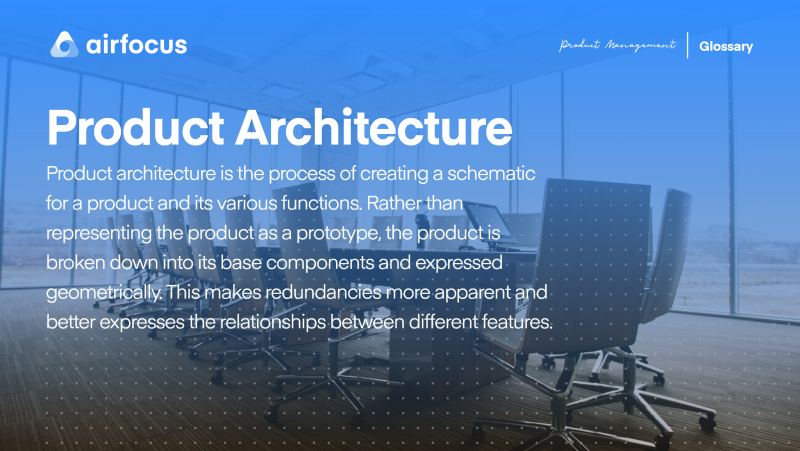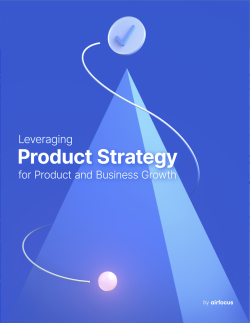Product Architecture
What is Product Architecture?
Definition of Product Architecture
Product Architecture is the process of creating a schematic for a product and its various functions. Rather than representing the product as a prototype, the product is broken down into its base components and expressed geometrically. This makes redundancies more apparent and better expresses the relationships between different features.
This concept may sound more complicated than it is. But in reality, creating a product architecture is a fairly simple exercise. The idea is to map the product's functions and features, rather than the product's physical design. For instance, you might draw a rectangle labeled "Product", when your product is really a tricycle.
Following this example, you may have bubbles coming off of your "Product" rectangle labeled "Handlebars" or "Wheels". Connecting to those bubbles may be other bubbles and squares labeled "Brakes" and "Shifters".
Mapping a product out in this way forces you to pay closer attention to its functional design, resulting in:
Greater visibility of vestige or unnecessary design choices
Clarity surrounding overlapping features — are there two things, trying to achieve the same goal?
And an increased commitment to the product’s functional performance (divorced from its aesthetic design).
What are the different types of product architecture?
Product architecture generally comes in two varieties.
The first is modular. Modular product architecture focuses on the relationships between the various features of a product. These functions are described briefly, while the ways that they interact are described in depth.
The second type of product architecture is integral. Integral architecture is just the opposite: it focuses on the function, purpose, and inner workings of each feature, with brief notes covering the relationships between them.
So which do you choose:
Integral design is a great way to cut the costs associated with a product and to increase its overall performance.
Modular design, on the other hand, helps create a smoother, more refined product. It makes dependencies more apparent, allowing you to create a product that has a longer lifespan, is less prone to errors, and needs fewer updates.
Who is a product architect, and what do they do?
The product manager will oversee the product creation process. This can become quite a technical role because they need to define the product and product architectures. This is why some teams will appoint someone to be a Product Architect.
The product architect is a purely technical role. They are responsible for defining how the product works. They also ensure the product comes together smoothly by facilitating, overseeing, and approving the architecture evolution.
Product architects are highly sought after because the role has become an influential fixture in most technology companies. Anyone looking to take up the role should be highly competent and creative with lots of technological expertise.
For large projects, the product architect role will be broken down into distinct areas, including data architecture, security architecture, and more. This may even be spread across a team of product architects with expertise in specific areas. In smaller teams, product architecture is often performed by the product manager.
It’s worth noting that there is no defined role for a product architect within the Scrum methodology. Scrum is not designed to operate on a technical level, so you may find that the role of product architect is shared throughout the scrum team. In other methodologies, the product architect role may be much more defined. This is especially true when working with methodologies that are more technical, like DevOps.
Product architect vs. product manager
As a product manager can perform the product architect role, we often see the terms used interchangeably. This may be fine for smaller teams, but when it comes time to work on bigger projects, it’s worth knowing the difference between the two roles.
The product manager role is a broad field. It’s far more loosely defined than other roles, and those performing the role should be prepared to put on a lot of different hats. Product management is the process of defining the “what” and “why” for the solutions that companies build, which are meant to solve customer problems.
They need to perform a holistic overview and facilitate the product’s development.
To do this, a product manager will factor in business goals, available resources, customer issues, metrics, market information, and much more.
Product architect is a much more technical role. They’re responsible for how the product works internally. This will include a variety of technical tasks, including the application of software architecture styles and design patterns to outline the client and server-side software components that implement user experience (UX), functional, and data application building blocks defined in the solution architecture document.
How to create a product architecture
Creating a product architecture can be completed in four steps.
First, you create the schematic. You can use any schematic template you like (Kafka schemas are fairly popular in product architecture). Just be sure to choose a schema that allows you to clearly express the features contained within your product.
Next, you'll want to group the features and elements of your product's schematic. How you choose to group them will vary depending on the type of product you’re designing. However, a key theme should be not only how much in common the items in groups have, but also how much they interact with one another.
After that, you'll want to lay out all of these elements in a geometric formation, representing the functions, flows, and patterns within your product. Remember that this is a map of sorts, so the paths between elements should define the structure.
And that brings us to the final and fourth step: to draw lines between the different elements to show if and how they interact with one another. In many ways, this is the most important step, as it's where the product architecture comes completely into focus.
Product architecture diagram
A product architecture diagram is a visualization tool that will inform the team about the business process, feature framework, and design idea of a product. The idea is to make a memorable visualization of the overall concept and direction of the product so they stay focused on the product vision during development.
Drawing an architecture diagram will also help the product manager identify how the product will evolve. It can also help to clarify dependencies and competition between the new product and products already on the market.
You can create a product architecture diagram in just four steps.
1. Prioritize tasks and draw the process
To get started, you should prioritize the tasks required to make the product come together. Based on the prioritization results, create a flowchart showing the process.
2. List the pages and modules
List the tasks, features, and requirements involved in each process according to the use path of target users. The key to this step is identifying potential issues and the tasks we need to perform to overcome them.
3. Cluster features
Group features together that have similar characteristics. This will help you assign tasks to the best person for the job rather than working on tasks in a hierarchical fashion.
4. Vertical and horizontal layering methods
Finally, the product architect must sort out the feature framework of the product from the horizontal and vertical perspectives, respectively. They need to put the product functions of the same scope or group on a horizontal level to get a basic product framework.
Product architecture example
Most products will require product architecture to make them work. Having a well-defined product architecture is valuable in outlining the next steps and ensuring that operations go according to plan. This is especially true with technology companies developing software or digital hardware.
Product development projects usually require technically minded professionals to build a product architecture. This allows us to outline and organize the development process clearly, without unnecessary methods, functions, or components. Some examples of projects where professionals may incorporate product architecture include:
Automobiles
Software
Computers
Security systems
Graphic design
Product architecture is crucial when it comes to building large, enterprise-scale products. The product architect will need to choose from various software architectural patterns that offer functionality and quality. An architectural pattern is a general, reusable solution to a commonly occurring problem in software architecture within a given context.
Examples of product system architecture include:
Layered pattern
Client-server pattern
Master-slave pattern
Pipe-filter pattern
Broker pattern
Peer-to-peer pattern
Event-bus pattern
Model-view-controller pattern
Blackboard pattern
Interpreter pattern
Each software architectural pattern has pros and cons, and it’s up to the product architect to weigh the product requirements and identify which will best fit the product.

General FAQ

Glossary categories
Create effective product strategy

Experience the new way of doing product management








